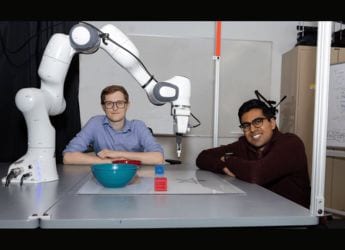- Home
- Science
- Science News
- Scientists Develop Two Level Strategy to Power Next Gen Lithium–Sulphur Batteries
Scientists Develop Two-Level Strategy to Power Next-Gen Lithium–Sulphur Batteries
A new dual-level design improves lithium–sulfur battery stability and performance.

Photo Credit: Seung-Keun Park and Inho Nam from Chung-Ang University
Dual-level carbon and cobalt design enhances lithium–sulfur battery performance.
Now, scientists at Chung-Ang University have developed a two-level engineering strategy that could enable lithium–sulphur batteries to outperform their standard commercial counterparts. Co-corresponding authors Associate Professor Seung-Keun Park and Inho Nam have shown how cobalt single-atom catalysts can be integrated with porous carbon nanofibers to tackle longstanding problems, including poor redox kinetics and rapid capacity degradation. The results, which were published in Advanced Fibre Materials on Sept. 24, 2025, represent a major step toward high-density energy storage devices of the future.
Cobalt-Infused Carbon Design Enhances Stability and Flexibility of Lithium–Sulfur Batteries
According to the Advanced Fibre Materials report, the researchers achieved this by embedding single cobalt atoms in a low-coordinated N3 environment within a porous carbon nanofiber structure. This structure sequesters lithium polysulfides, including their ability to enhance redox reaction kinetics, prevent loss of materials and eliminate mass throughout the process lifetime of a lithium–sulphur battery, which are critical limiting factors in performance.
The hierarchical carbon architecture gives mechanical stability, while the cobalt sites catalyse atomic-level reactions and result in longer life batteries with higher-capacity retention.
The two-tiered engineering approach of the team combines both structural and atomic enhancements. The well-defined porous carbon architecture and isolated cobalt single-atom sites enhance energy density and cycling stability.
According to Dr. Nam, it is a versatile binder-free material and can be directly used as an interlayer of pouch cells. The material survived bending and operated small devices and showed promise for flexible, portable, lightweight electronics applications.
The development could lead to new avenues of clean and sustainable energy production that have the potential to save the planet from a carbon-and material-laden future. The breakthrough is expected to boost innovation in EVs and renewable energy storage, plus other sustainable tech, too.
Get your daily dose of tech news, reviews, and insights, in under 80 characters on Gadgets 360 Turbo. Connect with fellow tech lovers on our Forum. Follow us on X, Facebook, WhatsApp, Threads and Google News for instant updates. Catch all the action on our YouTube channel.
Related Stories
- Samsung Galaxy Unpacked 2025
- ChatGPT
- Redmi Note 14 Pro+
- iPhone 16
- Apple Vision Pro
- Oneplus 12
- OnePlus Nord CE 3 Lite 5G
- iPhone 13
- Xiaomi 14 Pro
- Oppo Find N3
- Tecno Spark Go (2023)
- Realme V30
- Best Phones Under 25000
- Samsung Galaxy S24 Series
- Cryptocurrency
- iQoo 12
- Samsung Galaxy S24 Ultra
- Giottus
- Samsung Galaxy Z Flip 5
- Apple 'Scary Fast'
- Housefull 5
- GoPro Hero 12 Black Review
- Invincible Season 2
- JioGlass
- HD Ready TV
- Laptop Under 50000
- Smartwatch Under 10000
- Latest Mobile Phones
- Compare Phones
- Huawei Nova 15
- Huawei Nova 15 Pro
- Huawei Nova 15 Ultra
- OnePlus 15R
- Realme Narzo 90x 5G
- Realme Narzo 90 5G
- Vivo S50 Pro Mini
- Vivo S50
- Asus ProArt P16
- MacBook Pro 14-inch (M5, 2025)
- Huawei MatePad 11.5 (2026)
- OnePlus Pad Go 2 (5G)
- OnePlus Watch Lite
- Just Corseca Skywatch Pro
- Acerpure Nitro Z Series 100-inch QLED TV
- Samsung 43 Inch LED Ultra HD (4K) Smart TV (UA43UE81AFULXL)
- Asus ROG Ally
- Nintendo Switch Lite
- Haier 1.6 Ton 5 Star Inverter Split AC (HSU19G-MZAID5BN-INV)
- Haier 1.6 Ton 5 Star Inverter Split AC (HSU19G-MZAIM5BN-INV)

















